Stalking the Elusive Seeburg SMC1 Jr.
This story starts back in 1996,when I got a copy of the 1996 edition of the Always Jukin' 'Official Guide to Collectible Jukeboxes'. In thumbing through that issue, I naturally came to focus on the machines produced while I was employed at Seeburg. I noticed that a certain caption read '1978 Seeburg SMC1 Jr.', above a photo of what was obviously a Discotheque version of the 1964 U100 Mustang. I was familiar with the Mustang, since I saw it each day on the jukebox final assembly line in Seeburg's cavernous new building at 1500 North Dayton Street in Chicago. I immediately sent of fa letter to Mike Baute, AJ's publisher extraordinaire, explaining what the pictured jukebox really was. My letter was printed in the Dr. Know-it-all column the following month. As a testament to how influential AJ is, the now-defunct 'official Seeburg' website showed an identical picture for the SMC1 Jr. Indeed, even today one can find a photo of the Discotheque U100 masquerading as an SMC1 Jr., on at least one website:http://jukebox-guide.com/Seeburg/Collection.htm. That same site has a very murky photograph of what they call a 'DaVinci'. This machine is not quite a 100-78D Celestia (the Engineering name for which was indeed DaVinci), and not quite a real SMC1 Jr. (as you can see by the photos, but I'm getting ahead of myself), also known by its model name, 100-79M. I only recently found this model name to be correct for this machine. Repeated emails to that website in an attempt to straighten this situation out have gone unanswered. (Note: Seeburg used an 'Engineering' name for a machine internally, while it was in design. The Marketing group then came up with another name under which the machine was sold. In all references on this website, I use the Marketing name for the machine.)
But this got my interest up. Was the SMC1 Jr. ever built? What did it look like? I tried to answer these questions while researching my latest book 'Seeburg's Red Box and MCU Systems'. All I could find in print was a mention in Frank Adams' 'Seeburg Jukeboxes 1927-1989'. The text mentions that the SMC1 Jr. looks similar to the 100-78D Celestia. None of the people I contacted during my research could recall Seeburg ever building any SMC1 Jrs, which was the Engineering nickname for the 100-selection version of the SMC1 jukebox using the MCU or MicroComputer Unit. The MCU replaced the famous Seeburg Black and Gray boxes with the introduction of the SMC1 jukebox in 1978. Things were evidently quite chaotic at Seeburg during this time. They were in the midst of another bout of financial difficulties, which happened fairly frequently during the 1960s and 1970s. This time was much worse than those which came before: Seeburg went bankrupt in 1979, only to be bought by Stern Electronics, Inc., shortly thereafter.
 100-78D Celestia | 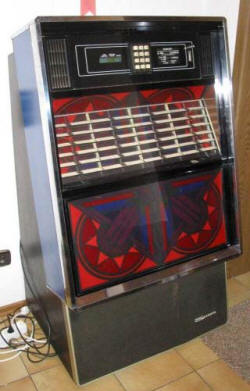 100-79M SMC1 Jr. (DaVinci) |
I worked for Seeburg, starting in 1964 on various production lines, working my way up until I became an incoming material inspector. I left in 1966 for military service, returning in 1972 as an Electronics Technician, now working in the Quality Assurance Department. I worked in Q.A., and later in the Engineering Department while going to college. After finishing college, I returned to work in the Engineering Department as a Junior Engineer, leaving Seeburg again in 1977 over a patent assignment disagreement with a member of the senior management. I left to join another major coin-op company for a couple of years, eventually joining Universal Research Laboratories (URL) in 1979as Chief Engineer and later Director of Engineering for Electronics. URL was the electronic design and manufacturing arm of Stern Electronics, until Stern went out of business in 1984. I left URL in 1982. Because of my leaving Seeburg in 1977, I was not involved in the development of the MCU, although I was assigned to travel to France to evaluate a microprocessor-controlled jukebox developed by one of Seeburg's affiliates. Due to my leaving Seeburg again in 1977, I never made that trip.
As a working, rather than just managing Chief Engineer at URL, one of my early projects was to re-design the MCU CPU board, in an attempt to make it more production-friendly. The MCU main CPU board was mounted in a metal chassis of fixed dimensions, and completely filled that box. The inevitable component additions to fix problems found in the field meant that some parts had to be mounted up in the air, making it mandatory to manually insert the parts in those areas of the board. URL used automatic component insertion equipment to keep labor costs low, so I had to make major modifications to the design in order to incorporate the necessary changes without 'growing' the Printed Circuit Board. A basic and overwhelming requirement was not to change the processor (a single-chip Mostek 3870) or the code contained in it, since there were several hundred in stock that were not to be scrapped. In addition to working on this design, I was in charge of all the Electronic Engineers, Software Engineers, Engineering Technicians, Printed Circuit designers, Production Engineering and Test Engineering personnel, and the Documentation Department. So, I was pretty busy. Also, we had a new system to design, the Video Music Centre, or VMC as it came to be known. This was the brainchild of the president of the Seeburg division and his marketeers, who thought it would be neat to replace the title strips with a TV display. We brought in a contractor for the VMC. After a couple of months, it became obvious that he was not getting anywhere, so I took on that project, too. Since I was keeping myself pretty busy with these goings on, while at the same time helping to lay out the Engineering offices of a new building for URL in Elk Grove Village Illinois, (a Northwest suburb of Chicago) I was unaware of many of the things taking place at the Stern's Diversey Avenue plant, on Chicago's Near North side.
Stern actually had three Directors-of-Engineering in those days. One was in charge of all video, pinball, and mechanical (except jukebox) development, one ran the Seeburg division, and me, responsible for all electronic development and software for all three product lines. The Seeburg Director was hired from a consumer electronics musical instrument manufacturer, and was focused on bringing the VMC to market. He spent little, if any, time with the other jukebox product line, the SMC2 which would be obsolete as soon as the VMC hit the line. After completing my design of the MCU3000 replacement for the MCU1 CPU board, I, too, focused on the VMC, along with my other video and pinball responsibilities. It made sense for he and I not to spend a lot of time on the existing Seeburg product, since the SMC1 had been running on Seeburg's production line for a year before they went bankrupt. Most of the bugs in the control system had been worked out; my recent re-design was merely to improve manufacturing. Stern's management also tried to insure the success of the jukebox product line by bringing over many of the key Engineering and Production people. They recognized the many years of experience these people brought with them. There was very little need for me to get involved with the current jukebox product.
Before going bankrupt, Seeburg had actually introduced and built a few of the new SMC2 model. Styling-wise, this model was a warm-over of the SMC1, adding the disco ball to the cabinet area directly in front of the mechanism and adding a lighting controller for it to the Phono Control Center or PCC2. The Stern (or as some call it, the Sternburg) version of this machine had a different color scheme, however. Originally, the vertical columns housing the tweeters were painted brown. When Stern took over, someone made the decision that the color scheme need to be made a bit brighter, so the formerly brown panels were changed to orange. This would be more in keeping with the out-of-the-ashes connotation of the 'Phoenix' model name for the SMC2. Since this machine came out around the end of October, some of us thought the color scheme had more to do with Halloween than anything else, but I must say that the orange color made it a very noticeable machine. The disco ball was to stay lighted all the time, so the controller board was deleted, and the PCC1 was used instead of the PCC2.
So, I was unaware of the fact that Stern was building SMC1 Jrs., even though I had on occasion walked down the Seeburg jukebox assembly line while visiting the Diversey Avenue plant for meetings with my Engineering Director peers and others in Stern Sales and Management. All I ever saw were SMC2s and the pilot run of the VMCon these tours. My ignorance lasted until I started trying to confirm or deny the existence of the SMC1 Jr, starting on that day in 1996 when I noticed the incorrect photo caption in the Always Jukin' Price Guide.
Getting information on this machine has proved quite difficult. It was certainly never shown at any of the industry shows I attended. I would be assigned booth duty at the Stern booth, but frequently stopped by the Seeburg booth, since I knew several of the people doing booth duty there. I've never seen a brochure on it, either. In recent years, I would occasionally do an Internet search for the SMC1 Jr, with never any results. If anyone has a brochure on this machine (or the machine), please contact me (note: see the postscript below). I interviewed several people directly involved with the development of the MCU system, both in Engineering and Management positions, and none could recall the machine. This meant to me that either the machine indeed did not exist and was merely a 'jukebox urban legend', or so few were built that they were forgotten after 20-some years. But then I got an email from a gentleman by the name of Raphael Görner, who lives in Germany.
I have a website (http://home.pacbell.net/fmillera) where I shamelessly promote the three books I have written about Seeburg jukeboxes built during the period from the late '60s to the early '80s. All three books, by the way, are available from Always Jukin'. There are also a few troubleshooting tips on the website, so if you are having problems with your Seeburg juke, check it out. There is also a link to my email, and I occasionally get questions from people doing a web search on Seeburg. That is how Raphael found me. His email asked if I knew where he could get schematics for the PCC3, used in the Seeburg E100-79M. I responded that I had never heard of a PCC3, and did his machine use a red box, or something different? But the Seeburg model number he gave me (E100-79M) told me something. First, this machine was built in 1979/1980; second, it was an export 100-selection machine (E100). But what about the 'M'? All of the later 100-selection machines I was aware of had the 'D' code in their model number, indicating they used the red box. Could this possibly be an SMC1 Jr? I hoped it was, but then again, I hoped it wasn't; since I had just gotten my latest book 'Seeburg's Red Box and MCU Systems' back from the printer, and it only briefly mentions the SMC1 Jr. At the time of writing, I had no idea that the machine existed, so the book only contains a sentence or two about it. Also, there is no mention in it of the PCC3 control center.
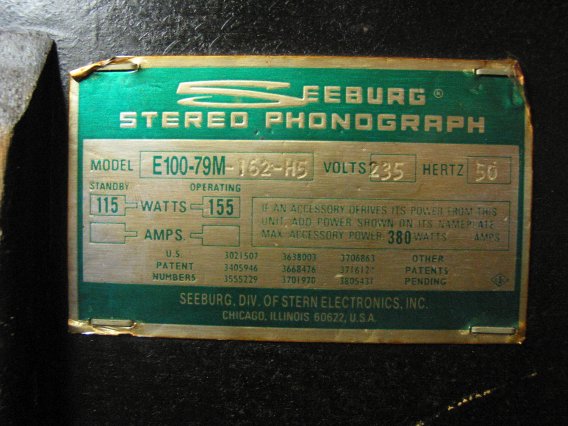 ID Tag from rear of E100-79M |
Over the course of several emails (some of which included photos that Raphael was kind enough to share with me, and also to give permission for them to be used in this article), I determined that this was indeed the long sought-after SMC1 Jr. Several of the photos Raphael sent me are reproduced here. In return, I scanned the PCC1 (figuring it had to be very similar to what he needed) and mechanism schematics, and the adjustment procedure for the-mechanism switches, and sent them to him. More about the PCC3 later, but to my knowledge, its schematic never made it into a Seeburg manual.
Here's what I have been able to piece together regarding the development and production of the SMC1 Jr:
Seeburg's Engineering Department had probably completed the design of the 100-79M SMC1 Jr., prior to the factory shutting down. I say 'probably' because I have not been able to confirm this, but it does seem reasonable, given the minimal changes between the 100-78D (D stands for Digital, meaning this machine uses the CSP1 RedBox) and the 100-79M ('M' must stand for Microprocessor or MCU). The MCU itself is identical between models, selecting between them by the connection of a jumper labeled '50 records' or '80 records'. The position of this jumper is sensed by the controlling software, which simply starts the internal down-count from 49 instead of 79 for the 50-record machine setting. The cabinet and graphics panels are identical between the 100-78D and 100-79M, except for the cabinet front selector panel, which mounts the selector,instruction window, coin entry, etc. The cabinet cabling is different between the two machines, and the SMC's CPA chassis must be mounted, but the mechanism carriage is identical between the SMC1/2 and the SMC1 Jr. Modifications to the rest of the mechanism would only involve deleting the Popularity Meter, Tormat, and Play Control Actuator, so it would seem that readying the Jr. for production was pretty simple.
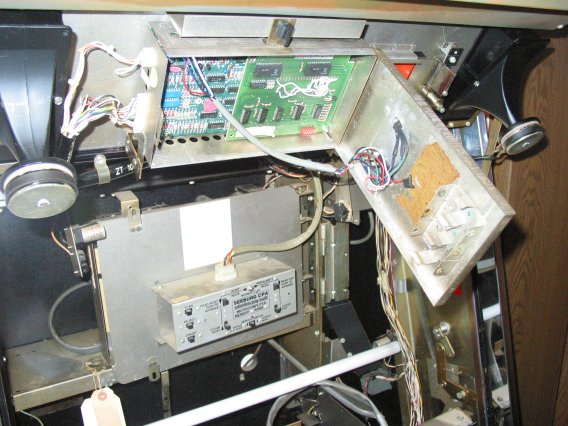 Interior of SMC1 Jr., with MPU-100 open |
In the 100-78D, the selector panel mounts a DES100 selector, identical to those used in the black and gray boxes, except for the selection-encoding PC board inside. Also located on this panel are the credit and 1st digit lamps, and a circular lamp display unit, which houses several of the same lamps as were used in the STD2 Entertainer and later machines. The display used a mirrored glass to give the same sort of 'infinity lamps' display as was used in the Entertainer, although there was no lamp animation in this model. It was, after all, the 'bargain basement' jukebox model of the Seeburg line. This and the graphics panel patterns are the only difference between the 100-78DCelestia and the earlier 100-77D Topaz.
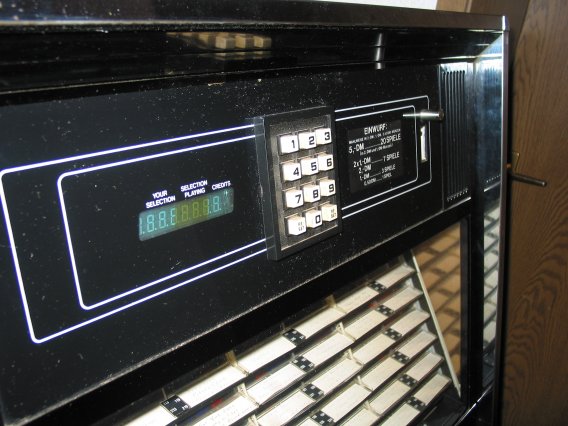 SMC1 Jr. Selector Panel |
When Stern took over, the first order of business was to clear out the factory on Dayton Street and move everything deemed necessary into an old factory building on the other side of the parking lot from Stern's Diversey Avenue plant, which was previously occupied by Chicago Coin. When Stern bought out Chicago Coin, they just moved into the building and took over. I think it would have made more sense to move the Stern operation into the Seeburg building, since it was much newer and had production features not available at the Stern plant such as plating and painting areas, but no one asked my opinion. I took a trip down to the Dayton Street plant shortly after the acquisition,looking for pieces of equipment we could use in our Elk Grove office. I remember it being very lonely walking around the abandoned offices I had worked in just a few years before.
Since the two 100-selection models were so similar, it must have made perfect sense for Stern to build as many 100-79M machines as they had sets of parts for. This would have come basically for 'free' since the parts were already in Seeburg inventory, and Stern (actually, the URL subsidiary) was already building MCUs for the SMC2product line. So, why not get rid of some inventory, and make a few bucks at the same time? How many were actually built would depend on how many sets of parts were there. Probably, a survey was made of the parts inventory specific to this machine, and additional parts ordered to permit enough machines to be built to exhaust the inventory of the most expensive part (which was probably the machined base casting for the 100-selection mechanism). I'm sure a few extra of several parts were kept in inventory for field replacement purposes.
So, there you have it. The SMC1 Jr did indeed exist, and a few (perhaps a hundred or so?) were built. But one question still remains: Did Stern's successor build any? When Stern went out of business in 1984, the Seeburg assets were bought up by a group of investors (headed by Bob Blankenbeckler, who was a former head of sales of the pre-Stern Seeburg). This new company, the Seeburg Phonograph Company, was the one who introduced the first CD (model SCD1) jukebox in 1986.
So did the Seeburg Phonograph Company build any SMC1 Jrs? I believe the answer is no. If what I said above is true, that Stern used up all remaining inventory to build the hundred or so 100-78M jukes, it would not make a lot of sense for the new company to incur the cost of buying additional inventory to build a few more machines. The new Seeburg was a very small company, focusing most of its assets on developing the new-technology CD juke. It was in this new machine that all the hopes and dreams were invested. Remember, at that time there were no CD jukes. Seeburg had traditionally been the trendsetter, and this was another opportunity to upset the market, to drive the competition back to the drawing board, just like in 1948 with the introduction of the M100A. But while this new development was going on, something needed to go out the door, both to keep the Seeburg name out in front of the operators and to get some needed cash flowing. The SMC3 model 'Prelude' was yet another warm over of the original SMC1, and filled the bill nicely. The SMC3 made perfect sense. So, why divert precious resources into a very low volume and expensive to procure-for SMC1 Jr? I've been in touch with a former Seeburg Field Service Engineer, who toured the Seeburg Phonograph Company at its Addison, IL plant. He tells me he saw SMC3 Preludes andSCD1 CD jukes going down the line, but never an SMC1 Jr. But, my good friend and expert on all things Seeburg, Ron Rich, has repaired an MCU100 (the name used for theSMC1 Jr MCU box). It contained boards that were not manufactured by URL (if the board has a rectangular label on it saying 'test | analyze', etc., it was built by URL), and also has a label saying 'MCU-100, S. P. Co'. I think one of two things happened with this MCU: First, it was returned for repair by a Seeburg operator or distributor, and S. P. Co. put one of their labels on it after the repair was complete. Second, S. P. Co. had some of the MCUs for the SMC3 modified for field replacement use in the Jr.
But what about the PCC3? The PCC3 deletes the lighting controller board mentioned above, along with the connector for the Dollar Bill Validator, and the stereo crossover network. Why this last chunk of circuitry? I think our faithful Seeburg Director of Engineering held crossover networks (and horn tweeters, for that matter) in disdain. In fact, I have heard of SMC2s that had their horn tweeters replaced with 3 x 5oval speakers, probably with no crossover. But, the biggest change made to this PCC3 is:two smaller transformers have replaced the power transformer. The chassis opening for the old transformer is covered over by a piece of sheet metal, and the two replacement transformers are mounted inside the chassis. This change may be yet another cost reduction, or it may be an act of desperation, trying to get as many machines out the door before that door got locked. It would be easier to tell if I could hold that PCC in my hands or talked to owners of a few more, but that machine is about 10,000 miles away.
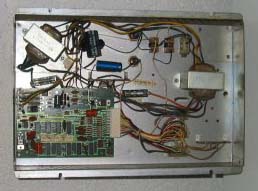 Interior PCC3 |
So ends the saga of the search for the SMC1 Jr. If anyone has any further information, please ask Mike to forward it to me.
Postscript:Since this article was published, some new information has come to light. First, I have a photo of a PCC3 with the 'normal' transformer (i.e., the one that the chassis was originally designed for, which partially protrudes through the chassis. This transformer may be the same as was used in PCC1 and PCC2. Since the PCC3 does not have provisions to support a dollar bill validator, the current rating of the 29 VAC winding can be reduced, resulting in a smaller transformer for the later production.
After having a chance to examine photos of other PCC3s, (another from Europe, and one from here in the U.S.) and some close-ups of the one above, I have come to think that my original conclusion about the two transformers was wrong. First, the two transformers are identical, down to part number and date code. The left-hand transformer has only its WHT-BLU and WHT-BLK secondary winding wires connected (the rest are cut short and wrapped with tape), while all of its primary winding wires are connected. This leads me to believe that the original power transformer (the one on the right) had a problem with this secondary, and that the one on the left was installed to fix the problem. The repairman must have been too lazy to remove the faulty transformer, since he would have had to disconnect all of the wires. Thanks to Dave Repp, who recently purchased (as of September, 2004) a domestic 100-79M, who sent me photos of it and answered innumerable questions from me. This is the first time I have heard of a U.S. version of the machine. Also thanks to Chris Guerts of Belgium for photos of his DaVinci and for sending me a photo copy of his DaVinci manual.
The comment above about Stern using the PCC1 instead of the PCC2 in their version of the SMC2 is incorrect. Stern actually used the same PCC2 as Seeburg used in the few SMC2s built before the bankruptcy took place, but whereas the Seeburg version included a small (1 inch by 1 inch) PC board and a chassis-mounted triac (an AC power switching semiconductor) to control the power to the small spotlights shining on the disco ball, Stern eliminated the board and triac, keeping the lamps on any time the machine was under power. Typically, this would have necessitated a change in model number, but Stern did not operate that way. Also, it appears that either very early (or very late, I'm not sure which) PCC3s used a larger transformer, probably the same as was used for the PCC2 or PCC4. The PCC4, by the way is identical to the Stern version of the PCC2 except that the additional connectors for the dollar coin have been eliminated. I believe the same power transformer was used in both, since the Light Organ used in the SMC3 (which uses the PCC4 as standard equipment) runs from the same voltage as the spot lamps used on the SMC2 to illuminate the disco ball. Thanks to Ron Rich for prompting this update.
Following are a pair of photos I downloaded from a recent eBay auction, selling a German language DaVinci brochure. This is the first brochure I have ever seen for this machine.
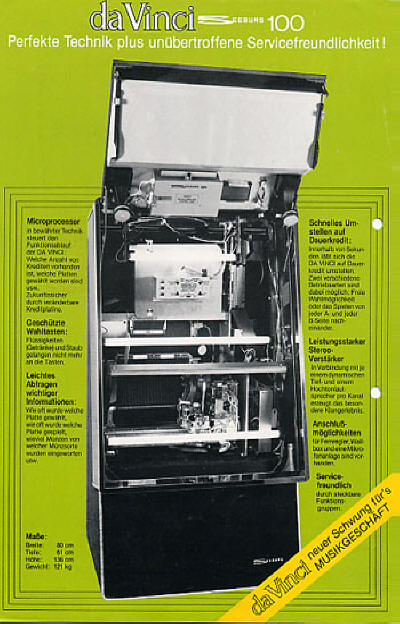 DaVinci brochure (front) | 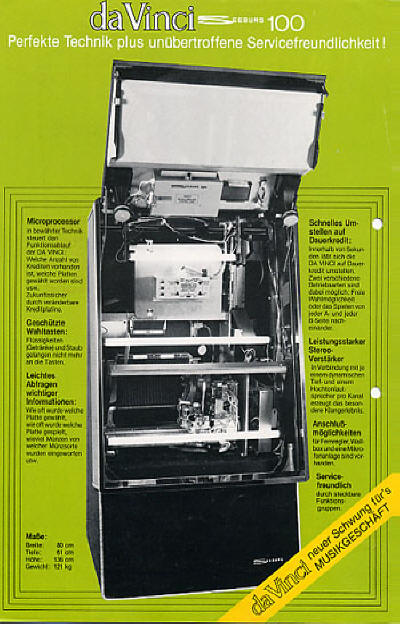 DaVinci brochure (back) |